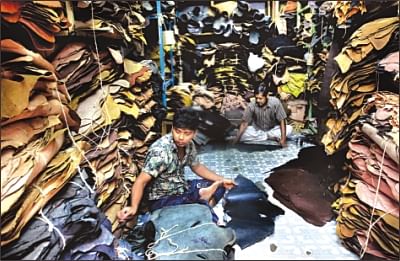Anthrax scare hurts leather industry

Workers sort leather at a wholesale shop in Bangsal, Dhaka. The earnings of local tanners and leather-goods makers went down as the anthrax scare has reduced the demand for beef. Photo: Shawkat Jamil
The growing public tendency to avoid beef as a precaution against the spread of anthrax in several districts has made cowhides scarce, and slashed the earnings of local tanners and leather-goods manufacturers by 80 percent last month.
Mohammed Aftab, president of the Bangladesh Hides and Skin Merchants Association, said that in the past month the supply of cowhides is 80 percent off the normal level; but the price per skin is fairly stable.
"We collect rawhides and skins mainly three times a year -- Eid-ul-Fitr, Eid-ul-Azha and Shab-e-Barat," he said. “But due to anthrax, the number of slaughtered cattle during Shab-e-Barat and Eid-ul-Fitr declined sharply in the last month.”
"As the incidents of finding anthrax started happening just before the Shab-e-Barat, many got scared and stop consuming beef. This reduced the slaughtering of cows sharply all over the country," he said.
The average of five lakh cows slaughtered every year during these festivals has declined to one lakh only, said Aftab.
Bangladesh normally has plenty of rawhides, as thousands of sacrificial cattle and goats are slaughtered every year to observe Eid-ul-Azha, a religious festival for the Muslims.
Local tanners collected more than 29 lakh pieces of cowhide and 45 lakh pieces of goatskin during the Eid-ul-Azha in 2009.
Local tanners produce four types of leather: rawhide, wet blue, crushed and finished leather. The country mainly exports crushed and finished leather, the demand and sale of which has declined on the international market.
Export Promotion Bureau data shows leather exporters earned $226 million in fiscal 2009-10, up from $177 million a year ago. The export was $284 million in fiscal 2007-08.
Of the total leather export from Bangladesh, 80 percent is crushed leather and the rest is finished. The products are mainly sent to the USA, Italy, Germany, Japan, Korea and China.
Meanwhile, the leather exports dropped significantly in the last two years, mainly due to a fall in demand amid global recession. However, exports went upward from February.
The annual market size of the leather industry is nearly Tk 3,500 crore, industry insiders say.
As the number of cattle slaughtered has declined, tanners have started to fear a dearth of cowhide persisting to Eid-ul-Azha, when nearly 60 percent of the year's total collection occurs.
Industry spokespeople are demanding the government immediately take steps to prevent the spreading disease with massive vaccination of farm animals before the prime time for collecting rawhide.
Mojibur Rahman, managing director of Sonali Hides, said that low collections of cowhide have raised costs, but what scares the tanners more is the prospect of this lasting into the upcoming Eid-ul-Azha, just eight weeks from now.
"The collection has been declining sharply from mid-August," he said. “If the situation continues, the leather industry will face a difficult time with lakhs of unemployed people.”
The scenario also haunts leather manufacturers and footwear makers, who similarly demand that the government take immediately measures to overcome anthrax.
Syed Nasim Manzur, managing director of Apex Adelchi Footwear, suggested the government should vaccinate the country's livestock immediately.
"The leather industry will fall in danger, if the government fails to address the issue with seriousness now, " he said.
"For example, entrepreneurs involved in leather processing and manufacturing leather goods will have to face difficulties in sourcing raw materials. So the government should not wait for the time when the problem becomes huge," he added.
He suggested the government seek help from relevant international and nongovernmental organisations to provide vaccines that cost only Tk 0.50 per cow.
Apart from that, the banks are also going cautious in disbursing loans for purchasing rawhide, because the spreading anthrax will risk the repayment system.
Ali Hossain Khan, general manager of the state-owned Sonali Bank, called the situation a momentary event but one that would nonetheless affect the rate of borrowing and lending.
"While the anthrax is affecting consumption and leather industry as a whole, we have to think about the repayment conditions," he said. "If the situation continues, the rate of lending must decline."

 For all latest news, follow The Daily Star's Google News channel.
For all latest news, follow The Daily Star's Google News channel. 




Comments